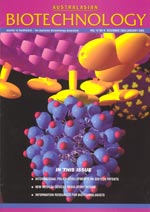
|
Australasian Biotechnology (backfiles)
AusBiotech
ISSN: 1036-7128
Vol. 11, Num. 5, 2001, pp. 5
|
Australasian Biotechnology, Vol. 11 No. 5, 2001, pp. 5
From the Editor
David Tribe, Acting Editor
Code Number: au01063
One really special item came across my
desk while I was editing this issue, and I
felt that I simply have to highlight this
particular item for readers interested in
the beneficial effects of technology. It
is a newly published book celebrating
the memory of economist Julian Simon,
who in 1980 famously placed a bet with
environmental pessimists about prices
of raw materials. Simon had offered
at that time to bet $10,000 that the
price of any raw material picked by
his intellectual opponents would fall in
value over any period longer than a year.
In 1990 Simon won his bet when, not
only did the value of a total basket
of raw materials fall in real terms, but
each individual item on a list including
copper, nickel, tin, and tungsten - had in
real terms fallen in price.
The book in question is The Skeptical
Environmentalist: Measuring the Real State
of the World by Bjorn Lomborg,
published 2001 by Cambridge
University Press. It is a must read
for anyone seriously interested in the
ongoing debate about the social impacts
of biotechnology, and especially the
issues posed by GM-crops.
Lomborg’s message is quite simple, but
documented exhaustively in the book.
The past 400 years have bought us
fantastic and continued progress. We
have more leisure time, greater security,
fewer accidents, more education, more
amenities, higher incomes, fewer
starving people, more food, and
healthier and longer lives. We have,
however, been misled by the news media
and many vocal pessimists to believe
exactly the opposite, by what Lomborg
calls ‘The Great Fable of the Litany’.
Lomberg spends some 500 plus pages
demonstrating that this pessimistic
Litany of environmental and social crisis
is almost exclusively based on myths,
many of which are endlessly propagated
by well-meaning, compassionate people.
In his final chapter Lomberg offers a
route away from the paralyzing fear
created by endless repetition of The
Litany. We must prioritise risks, as
we simply do not have the unlimited
resources need to avoid all risk. We
must also, as a community, get used to
the idea that all decisions are in reality, a
trade-off between various risks.
Please read and enjoy the book if you
want to retain your optimism about the
value of technology. And, if you hope
for a beautiful future, draw the book
to the attention of any pathological
pessimists you know. It leaves both
Limits to Growth and Earth in the Balance
in the dust, where they belong.
The current flood of the news releases
coming through the editor’s desk at
Australasian Biotechnology wonderfully
illustrates the generally buoyant state
of the industry, and we take much
pleasure in presenting a selection of
these briefings in this issue of the
journal. Such a healthy signal of
commercial activity - along with the
other signals of growth in interest,
investment, commercial links, and
technology development, which come
from virtually all the geographical
regions - augers well for continuing
expansion of our industry. For that
reason, it has been especially enjoyable
for me to briefly take over from our
regular Editor, Martin Playne, while he
is on leave.
Copyright 2001 - AusBiotech
|
